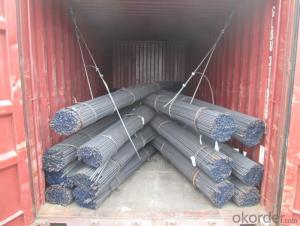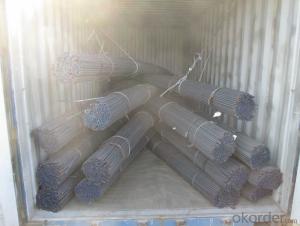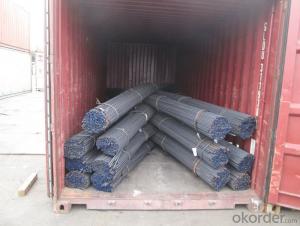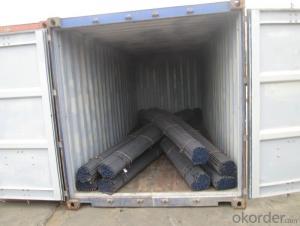JIS G3101 SS400 Spring Steel Bar with high quality
- Loading Port:
- Tianjin
- Payment Terms:
- TT or LC
- Min Order Qty:
- 25 m.t
- Supply Capability:
- 10000 m.t/month
OKorder Service Pledge
OKorder Financial Service
You Might Also Like
Item specifice
Product Description:
OKorder is offering Spring Steel Bar with high quality at great prices with worldwide shipping. Our supplier is a world-class manufacturer of steel, with our products utilized the world over. OKorder annually supplies products to European, North American and Asian markets. We provide quotations within 24 hours of receiving an inquiry and guarantee competitive prices.
Product Applications:
Spring Steel Bar with high quality are ideal for structural applications and are widely used in the construction of buildings and bridges, and the manufacturing, petrochemical, and transportation industries.
Product Advantages:
OKorder's Spring Steel Bar with high quality are durable, strong, and resist corrosion.
Main Product Features:
· Premium quality
· Prompt delivery & seaworthy packing (30 days after receiving deposit)
· Corrosion resistance
· Can be recycled and reused
· Mill test certification
· Professional Service
· Competitive pricing
Product Description:
Spring Steel can be divided into two types. One is carbon spring steel, and other one is alloy spring steel.
Alloy spring steel is based on carbon spring steel, by adding one or more alloying elements to improve the mechanical properties, hardenability and other properties to meet the requirement for manufacture all kinds of spring steel.
Specification of Spring Steel Bar:
-Material: SUP6
-Standard: JIS
-Production: Hot rolled or cold rolled
-Type: Spring Steel
-Alloy or no: Alloy
-Micro Structure: Tempered troostite
Mechanical Properties:
-Tensile Strength σb (MPa): ≥1274 (130)
-Yield Strength σs (MPa): ≥1176 (120)
-Elongation δ10(%): ≥5
-Percentage reduction of area: ψ (%): ≥25
-Hardness:
1, Hot rolled, ≤321HB
2, Cold drawn + Heat treatment: ≤321HB
Usage/Applications of Spring Steel Bar:
-This is silicon-manganese spring steel that is used widely. Its strength, elasticity and hardenability are little higher than 55Si2Mn.
- Products of this material are used as flat spring o spiral spring with diameter less than 30mm that bear a large load during the fabrication of trains, cars and tractors.
-The principal material of valve spring.
Packaging & Delivery of Spring Steel Bar:
-Packing Detail: The products can be packed in bundles by steel wires.
-Marks: We will make color marks to make sure that it’s more convenient for customers to distinguish their products from other products at the destination port and we will tie tag marks up to each bundle to make sure that customers know the specifications of each bundle like product’s name and size and other information of products.
-Delivery Detail:
1, Delivery time: 30~45 working days after receive buyer’s T.T. or L/C.
2, Delivery status should be written in the contract. (Heat treatment or no)
Transportation:
1, The products can be delivered by bulk vessel or by container. As for container, products with the length of 6m will be loaded in 20’ container, with 9m or 12m, in 40’ container.
2, The maximum quantity of loading of container is 25 tons.
3, The products are usually transported to the nearest port from the production place.
FAQ:
Q1: Why buy Materials & Equipment from OKorder.com?
A1: All products offered byOKorder.com are carefully selected from China's most reliable manufacturing enterprises. Through its ISO certifications, OKorder.com adheres to the highest standards and a commitment to supply chain safety and customer satisfaction.
Q2: How do we guarantee the quality of our products?
A2: We have established an advanced quality management system which conducts strict quality tests at every step, from raw materials to the final product. At the same time, we provide extensive follow-up service assurances as required.
Q3: The products are invoicing on theoritical weight or on actual weight?
A3: We can do it in both manners, according to the customers' request.
Image:
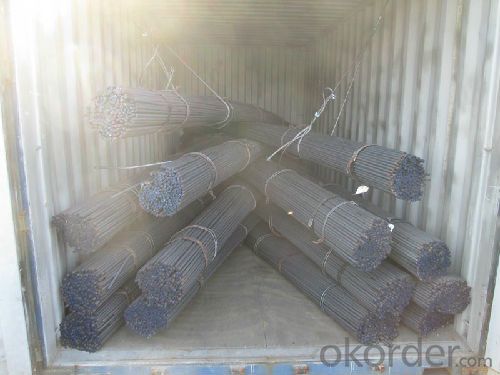
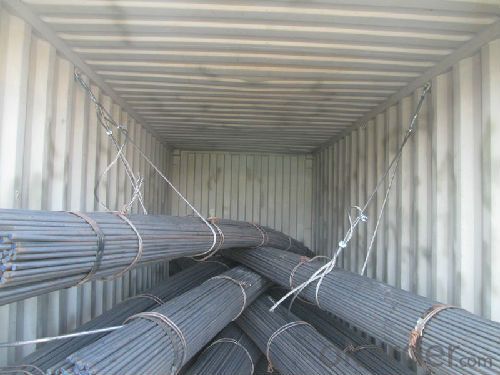
- Q:Can steel round bars be used in the oilfield equipment industry?
- Steel round bars have a wide range of applications in the oilfield equipment industry. They are highly favored for their remarkable strength, durability, and resistance to corrosion. In fact, they are extensively utilized in the manufacturing of numerous components and equipment, including drill collars, drill bits, valves, and pump shafts. By incorporating steel round bars, the oilfield industry ensures that its equipment can endure the severe conditions and immense pressures encountered during operations. Furthermore, steel round bars can be effortlessly welded and machined to meet particular specifications, adding to their versatility and making them an optimal selection for the oilfield sector.
- Q:Can steel round bars be used for making suspension springs?
- Certainly! Suspension springs can indeed be made using steel round bars. The reason steel is often chosen as the material for suspension springs is because of its exceptional strength and durability. By forging or shaping the round bars into the desired spring shape, and subsequently subjecting them to heat treatment, the desired spring characteristics can be achieved. Moreover, steel round bars can be effortlessly machined and drilled to accommodate various suspension systems and components. Nevertheless, it is crucial to carefully consider the specific requirements and load capacity of the suspension system, in order to ensure that the selected steel round bars are appropriate for the intended application.
- Q:Are steel round bars suitable for the production of valves?
- Yes, steel round bars are suitable for the production of valves. Steel is a strong and durable material that can withstand high pressure and temperature conditions commonly encountered in valve applications. The round shape of the bars allows for easy machining and shaping of various valve components. Additionally, steel offers excellent corrosion resistance, making it an ideal choice for valves used in industries such as oil and gas, chemical, and water treatment.
- Q:Can steel round bars be used in the production of construction materials?
- Yes, steel round bars can be used in the production of construction materials. They are often used as reinforcement in concrete structures, such as beams, columns, and foundations. The high strength and durability of steel make it an ideal choice for construction applications.
- Q:How do I determine the strength and hardness of a steel round bar?
- In order to assess the strength and hardness of a steel round bar, various methods and tests can be employed: 1. Tensile Test: The strength of a steel bar is commonly determined through this method. It involves subjecting the bar to a tensile force until it fractures, and measuring the maximum force or load it can endure. This test provides information on the bar's ultimate tensile strength, yield strength, and elongation. 2. Hardness Test: Several techniques, such as the Rockwell, Brinell, and Vickers hardness tests, can be utilized to measure the hardness of a steel bar. These tests entail indenting the bar's surface using a standardized indenter and gauging the resulting indentation size. The obtained hardness value indicates the bar's resistance to deformation and wear. 3. Charpy Impact Test: This test gauges the toughness of a steel bar by striking it with a swinging pendulum and measuring the energy absorbed during fracture. It helps assess the bar's ability to withstand brittle fracture under conditions of impact loading. 4. Microstructural Analysis: Examining the microstructure of the steel bar through microscopic observation can offer insights into its mechanical properties. By preparing a polished and etched sample and inspecting it under a microscope, the presence of different phases, grain size, and any structural irregularities can be observed. Various microstructural features can impact the bar's strength and hardness. 5. Chemical Composition Analysis: The chemical composition of the steel bar, particularly the carbon content, significantly influences its strength and hardness. Analyzing the composition using techniques like spectroscopy or chemical analysis can provide valuable information about the bar's mechanical properties. It should be emphasized that these tests and techniques must be carried out by qualified professionals in a controlled laboratory setting to ensure accurate and reliable results. Moreover, specific standards and specifications may exist for different applications, so referring to relevant standards and guidelines can offer further guidance on determining the strength and hardness of a steel round bar.
- Q:Can steel round bars be used for making conveyor belts?
- No, steel round bars are not suitable for making conveyor belts as they lack the necessary flexibility and surface properties required for effective and efficient conveyor belt operation. Conveyor belts are typically made from materials such as rubber or synthetic fabrics that provide durability, grip, and flexibility to facilitate the movement of goods.
- Q:How are steel round bars inspected for quality?
- To ensure that steel round bars meet the necessary standards, various methods are utilized to inspect their quality. Typically, the inspection process encompasses both visual examination and testing procedures. The initial step in evaluating the quality of steel round bars involves visual inspection. Qualified inspectors visually examine the bars for any surface defects, including cracks, scratches, dents, or other irregularities that could potentially impact the structural integrity or performance of the bars. Moreover, dimensional inspection is carried out to verify the diameter, length, straightness, and overall shape of the round bars. Precision measuring instruments are employed to ensure that the bars adhere to the specified tolerances and requirements. In addition to visual inspection, diverse testing methods are employed to assess the mechanical properties and chemical composition of the steel round bars. The most common testing procedures encompass: 1. Tensile Testing: This test measures the strength and ductility of the steel bars by subjecting them to tension until they fracture. It aids in determining the ultimate tensile strength, yield strength, and elongation of the material. 2. Hardness Testing: It is performed to determine the hardness of the steel round bars, which serves as an indicator of its resistance to deformation or wear. The Rockwell, Brinell, and Vickers hardness tests are commonly utilized for this purpose. 3. Ultrasonic Testing: This non-destructive testing method utilizes high-frequency sound waves to detect any internal defects or discontinuities in the steel bars. It facilitates the identification of flaws such as cracks, inclusions, or voids that may negatively impact the material's quality. 4. Chemical Analysis: Steel round bars undergo chemical analysis to determine their chemical composition and ensure they meet the required specifications. This analysis helps verify the percentages of different alloying elements present in the steel, thereby ensuring it possesses the desired properties. All these inspection methods are carried out by well-trained professionals or certified third-party inspectors who possess extensive knowledge of the specific industry standards and guidelines. Through the combination of visual examination and precise testing techniques, the quality of steel round bars can be comprehensively assessed, guaranteeing their suitability for their intended applications.
- Q:Can steel round bars be used in the manufacturing of lighting fixtures?
- Yes, steel round bars can be used in the manufacturing of lighting fixtures. Steel is a versatile material that offers strength, durability, and a sleek appearance, making it suitable for various applications, including lighting fixtures. Steel round bars can be shaped, cut, and welded to create different components of lighting fixtures, such as frames, bases, or decorative elements. Additionally, steel can be finished with various coatings or finishes to enhance its aesthetic appeal and protect it from corrosion.
- Q:How do you prevent steel round bars from rusting?
- To prevent rusting of steel round bars, there are several effective methods at your disposal: 1. Employ a protective coating: One effective way to prevent rust on steel round bars is to apply a protective coating. This can be accomplished through the use of paint, epoxy, or other coatings that are resistant to corrosion. The coating acts as a barrier between the steel and moisture, thus preventing oxidation and the formation of rust. 2. Ensure dryness of the bars: Moisture is a key factor in the formation of rust. Therefore, it is crucial to keep the steel round bars dry at all times. Store them in a dry area, away from water or humidity. If the bars come into contact with water, be sure to thoroughly dry them to prevent any residual moisture from causing rust. 3. Implement proper ventilation: Adequate ventilation is essential for reducing moisture levels in the air, thereby preventing rust. Make sure that the storage area or facility where the steel round bars are kept has good airflow and is well-ventilated. This will minimize the accumulation of moisture and the formation of rust. 4. Utilize corrosion inhibitors: Corrosion inhibitors are chemical compounds that can be applied to the surface of steel round bars to prevent rust. These inhibitors work by creating a protective layer on the steel, inhibiting the oxidation process. There are various types of corrosion inhibitors available, so choose the one that fits your specific needs. 5. Regularly maintain and inspect: Routinely inspect the steel round bars for any signs of rust or damage. If any rust spots are detected, promptly remove them using a wire brush or sandpaper, and apply a fresh coat of protective coating. Additionally, ensure that the bars are stored in a clean and dry environment to minimize the risk of rust formation. By adhering to these preventive measures, you can significantly decrease the likelihood of rusting in steel round bars and extend their lifespan.
- Q:What are the advantages of using molybdenum-alloy steel round bars?
- There are several advantages of using molybdenum-alloy steel round bars in various applications. Firstly, molybdenum enhances the strength and hardness of the steel, making it an ideal choice for industries that require high strength materials. The addition of molybdenum improves the resistance to deformation under heavy loads, making the round bars more durable and long-lasting. Secondly, molybdenum-alloy steel round bars have excellent heat resistance properties. This makes them suitable for applications that involve high temperatures, such as in the manufacturing of heat exchangers, boilers, and furnace components. The steel's ability to withstand extreme temperatures without losing its strength and structural integrity is a significant advantage. Another advantage is the corrosion resistance provided by molybdenum. Molybdenum-alloy steel round bars exhibit superior resistance to corrosion in various environments, including acidic and alkaline conditions. This makes them an ideal choice for applications in corrosive industries such as chemical processing, oil and gas, and marine environments. Furthermore, molybdenum-alloy steel round bars offer excellent weldability and machinability. The molybdenum content ensures that the steel maintains its structural integrity during welding and machining processes, minimizing the risk of cracks or deformations. This ease of fabrication allows for greater flexibility in design and construction. In addition to these advantages, molybdenum-alloy steel round bars also offer good wear resistance, making them suitable for applications that involve abrasive conditions. Their ability to withstand wear and tear ensures a longer service life, reducing maintenance and replacement costs. Overall, the advantages of using molybdenum-alloy steel round bars include increased strength, heat resistance, corrosion resistance, weldability, machinability, and wear resistance. These properties make them a preferred choice in various industries where durability, reliability, and performance are essential.
1. Manufacturer Overview |
|
|---|---|
| Location | |
| Year Established | |
| Annual Output Value | |
| Main Markets | |
| Company Certifications | |
2. Manufacturer Certificates |
|
|---|---|
| a) Certification Name | |
| Range | |
| Reference | |
| Validity Period | |
3. Manufacturer Capability |
|
|---|---|
| a)Trade Capacity | |
| Nearest Port | |
| Export Percentage | |
| No.of Employees in Trade Department | |
| Language Spoken: | |
| b)Factory Information | |
| Factory Size: | |
| No. of Production Lines | |
| Contract Manufacturing | |
| Product Price Range | |
Send your message to us
JIS G3101 SS400 Spring Steel Bar with high quality
- Loading Port:
- Tianjin
- Payment Terms:
- TT or LC
- Min Order Qty:
- 25 m.t
- Supply Capability:
- 10000 m.t/month
OKorder Service Pledge
OKorder Financial Service
Similar products
New products
Hot products
Related keywords
